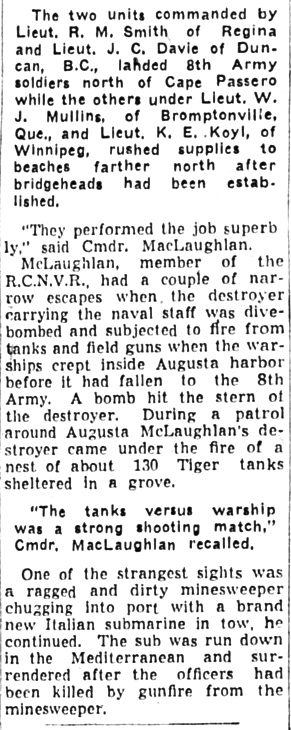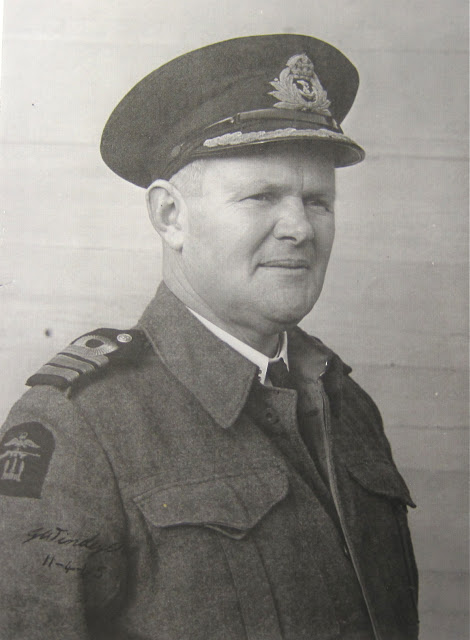Canadian Army and Navy Win Praise in Sicily
Excerpts from The Winnipeg Tribune
The war in Sicily is coming to a close as the German army evacuates, as Italian prisoners are taken in large numbers, as Allied troops gain fuller control of the island, and as Canadians in Combined Ops rest - and repair landing crafts in Valetta's Great Harbour, Malta.
While the Canadians in Malta prepare for ferrying duties to come during the invasion of Italy (D-Day was planned for September 3, unbeknownst to them), news hits Canadian shores about progress in the Mediterranean.
Canadian seamen attached to Combined Operations gain some recognition in an article that appeared two days later in the Tribune. Their commanding officers (Lieut. Mullins and Lieut. Jake Koyl) are mentioned in an article's third paragraph:
The following is a report made by Lieut. Koyl about where sailors in charge of landing craft stayed during the invasion of Sicily and how they fared at the time:
The 81st Flotilla Officer, Lieutenant Mullins, went ashore on the second day, after a day of ferrying high octane gas through air attacks, and managed to arrange with the Army for the billeting and feeding of his men at a rough camp about three minutes walk from the beach.
The 80th did not fare so well and had to fend for themselves. They found, after living and feeding from ship to ship until the 21st of July, a cattle cave near the beach, which provided shelter but was uncomfortable and dirty. Both Flotillas lived mainly from Army "Composite" rations and what meals they could get from merchant ships they were unloading.
The LCM's were kept on the job for longer than had originally been planned. Ports had been destroyed and obstructions in the water also hindered ships in coming alongside any dock. Therefore a greater volume of stores had to be taken over the beaches. This proved unexpectedly difficult in the last days of the operation when ships were unloading into LCM's bulky cargoes* originally intended for discharge onto the docks of Catania.
(*Editor: Life was not all bad for the sailors unloading LCMs. My father, a member of the 80th Flotilla mentioned above, recalls that one day a shipment of Navy Rum landed aboard his craft. Labels read, "Consigned to Officer’s Mess." It didn’t arrive at the Officer's Mess.)
Jake Koyl continues:
In spite of everything the projected totals of stores taken over the beaches from Landing Craft was considerably exceeded; in other words, the operation as a whole was most successful in its achievement, however hard it was on the personnel who did the job....
Koyl adds details from another officer's report:
"GEORGE" sector will close 1200 tomorrow 5th of August. In 25 days, during two of which we had no ships here, we have discharged 24,959 personnel, 4,871 vehicles and 19,814 tons of stores. In addition 1,900 prisoners of war have been embarked....
That is a grand job well done and it has been done due to three things: common sense, guts and real co-operation between services.
At the end of the 28 days, the record of the Canadians was particularly good. The eighty operational LCM's proceeded under their own power down the east coast of Sicily, anchored under the shelter of Cape Passero, and made Malta the next afternoon, the 7th of August. (Page 181 - 182, Combined Operations by Londoner Clayton Marks)
Excerpts follow from The Winnipeg Tribune to provide details about the war's progress as reported in August, 1943:
Though the influence of German submarines may have been lower than expected in the days before Operation Husky began (July 10, 1943), one sharp-eyed Canadian in Combined Ops (aboard a US Liberty ship outside Alexandria) spotted a torpedo as Allied ships headed north for Malta and then Sicilian shores, and recalls the following:
Canadians were kept informed by several Canadian war correspondents, including Ross Munro:
Canadians at home likely welcomed news collected by the National Film Board and other media sources:
Success in Sicily did not come without cost. Reports about those killed or injured appear below, as does the following article about the natural consequence of high losses on the field and at sea:
Success in Sicily opened the door for the invasion of Italy. Step by step the Allies would advance:
The Canadian Army wins praise as the final push in Sicily is realized:
The Winnipeg Tribune reports on a memorial service held in honour of those lost at Dieppe, one year after the fateful raid:
Praise for the Canadian troops at Dieppe is also found in the New York Times:
The cost of war continues to rise. The "Butcher's Bill" is always high:
The Canadian Navy, represented in part by Canadians in Combined Ops (most were volunteers from RCNVR) in Sicily, was growing and taking on an ever-larger role in other areas during WW2.
That HMCS Huron "has gone into service"is reported below, mentioned alongside HMCS Iroquois and HMCS Athabaskan.
Final notes:
In a recent London publication, Knowing No Defeat, re "the 57 men of London South Collegiate who gave their lives in WW2", one reads of the destruction of the Athabaskan on April 29, 1944, with great loss of life.
We read:
....there was chaos on the water. The Athabaskan was hit once in the gearing room and was crippled, yet still kept after her target. The second torpedo hit was fatal. Large fires broke out and the crew was just starting to fight the worst of them when a magazine exploded, producing flames visible for 50 kilometres. The blast threw blazing oil all over the forward part of the ship and flung most of the crew overboard. The Athabaskan quickly disappeared....
Aboard the destroyer at the time was a man who once lived at 65 Cathcart Street, London (just a few doors south of my current address).
Earl Gordon Guest is buried in France
I read that "Earl Gordon Guest died that morning, along with 127 of his fellow sailors, just a month before his 22nd birthday." (Page 42, Knowing No Defeat)
As well, the Tribune article mentions that Cmdr. Raynar, one of the officers aboard HMCS St. Laurent, won the D.S.C. "for action against enemy submarines."
Another officer once aboard the St. Laurent also won the D.S.C. and went on to be in command of a Combined Operations training centre, HMCS Givenchy III, located on The Spit at Comox, Vancouver Island from 1943 - 46.
Windeyer died in 1984 and a brief death notice in the Montreal Gazette informs readers of some of his WW2 experience, some of which involve successful submarine chases, successful enough to catch the attention of an author and movie producer.
In a letter to my father, Mr. Ron Kelly of the USA mentions Windeyer's connection to the HMCS St. Laurent:
The above letter also provides a link to another connection to Combined Operations.
HMS Itchen and HMCS St. Croix were both torpedoed during the war and one of the few survivors, William Fischer, was later sent to the Combined Operations centre on Vancouver Island.
My father writes:
Wm. Fischer, a stoker (not of Combined Ops but of R.C.N.V.R.), was stationed there (Editor - i.e., Comox). He had, I believe, an unequalled experience. He was on an Atlantic convoy run, on H.M.C.S. St. Croix, and one night in rough seas the St. Croix was sunk and he was the lone survivor. His life jacket had lights on and later he was picked up by the English ship H.M.S. Itchen. It in turn was torpedoed and Fischer was one of three survivors. They took him and his wife on saving bond tours, etc., but when he was asked to go to sea again, he said he would go to cells first. With an experience like that I would have too. He was lucky to be alive. (Page 41, "DAD, WELL DONE")
More newspaper articles related to Combined Operations and their activities during WW2 will follow.
Please link to Articles: Sicily, August 12 - 14, 1943 - Pt 15.
Unattributed Photos GH



















































No comments:
Post a Comment